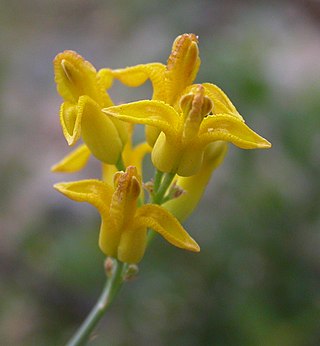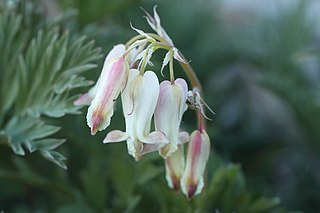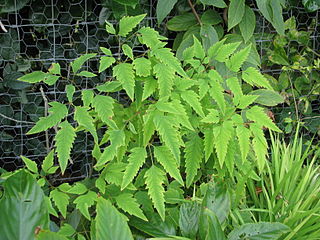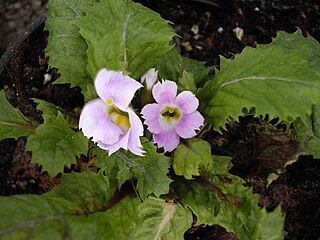
Fumarioideae is a subfamily of the family Papaveraceae. It was formerly treated as a separate family, the Fumariaceae. It consists of about 575 species of herbaceous plants in 20 genera, native to the Northern Hemisphere and South Africa. The largest genus is Corydalis.

Dicentra, known as bleeding-hearts, is a genus of eight species of herbaceous plants with oddly shaped flowers and finely divided leaves, native to eastern Asia and North America.

The Papaveraceae are an economically important family of about 42 genera and approximately 775 known species of flowering plants in the order Ranunculales, informally known as the poppy family. The family is cosmopolitan, occurring in temperate and subtropical climates, but almost unknown in the tropics. Most are herbaceous plants, but a few are shrubs and small trees. The family currently includes two groups that have been considered to be separate families: Fumariaceae and Pteridophyllaceae.

Dicentra cucullaria, Dutchman's britches, or Dutchman's breeches, is a perennial herbaceous plant, native to rich woods of eastern North America, with a disjunct population in the Columbia Basin.

Dicentra formosa is a flowering plant with fern-like leaves and an inflorescence of drooping pink, purple, yellow or cream flowers native to the Pacific Coast of North America.

Platystemon is a monotypic genus of flowering plants in the poppy family containing the single species Platystemon californicus, which is known by the common name creamcups. It is native to Oregon, California, Arizona, Utah and Baja California, and is found in open grasslands and sandy soils below 6,000 feet (1,800 m) elevation.

Ehrendorferia chrysantha, with the common name golden eardrops, is a biennial to perennial plant in the family Papaveraceae.

Dicentra nevadensis, the Sierra bleeding heart or Tulare County bleeding heart, is a perennial plant endemic to gravelly outcroppings in the Sierra Nevada peaks of Tulare and Fresno Counties in California.

Dicentra pauciflora is a species of flowering plant in Dicentra, the genus containing the bleeding-hearts. Its common names include shorthorn steer's head and few-flowered bleeding-heart. This perennial wildflower is native to the US states of Oregon and California, where it grows high in the mountains in gravelly soils. This is a short bleeding-heart, approaching 10 centimeters in maximum height. From a rhizome beneath the soil it extends several erect petioles, each holding a leaf divided into leaflets which are each divided into smooth, fingerlike lobes. It also erects a thin stem which is topped with an inflorescence of one to three nodding flowers. Each flower is a shade of pink or purple to white, with two curving outer petals flexed back against the flower, and inner petals extended straight outward. The fruit is a capsule just over a centimeter long. The specific epithet pauciflora, refers to the Latin term for 'few flowered'.

Dicentra uniflora, the longhorn steer's head, is a herbaceous perennial growing from a tuber, native to gravelly soils in mountains of the western United States.

Epilobium obcordatum is a species of perennial plant in the evening-primrose family (Onagraceae), known by the common name rockfringe willowherb and rock fringe. It is native to the western United States from California to Idaho, where it is found in rocky mountainous areas, at altitudes of 7,000 ft (2,100 m) to 13,000 ft (4,000 m). This small perennial is clumpy to mat-forming and spreads from a woody caudex, especially in nooks between rocks. It has stems lined with oval or rounded leaves which spread parallel to the ground or ascend somewhat. At the tips of the thin stems are flowers each with four petals. The petals are magenta to purple, rounded and notched, often in a perfect heart shape, and are one or two centimeters long. The glandular, club-like, ridged fruit is a capsule two to four centimeters long growing on a short stalk.

Euphorbia misera is a semi-succulent shrub in the genus Euphorbia commonly known as the cliff spurge or coast spurge. A drought-deciduous shrub, it is typically found as a gnarled, straggly plant occupying seashore bluffs, hills and deserts. Like other members of its genus, it has a milky sap, which can be found exuding out of the light gray bark when damaged. The alternately-arranged leaves are round and folded in the middle, with small hairs on them. The "flowers" can be found blooming year-round, and are colored maroon or yellow in the center with 5 white to light-yellow petal-like appendages attached outside. This species is native to the Baja California peninsula and Sonora in Mexico, and the coast of southern California in the United States, where it is a rare species. It is threatened in some localities by the development of its coastal habitat, which tends to be prime locations for high-end residential and commercial developments.

Calochortus albus is a North American species in the genus Calochortus in the family Liliaceae. It is also known by the common names fairy lantern, white fairy lantern, pink fairy lantern, lantern of the fairies, globe lily, white globe lily, white globe-tulip, alabaster tulip, Indian bells,satin bells, snowy lily-bell, and snow drops.

Dicentra eximia is a flowering plant with fernlike leaves and oddly shaped flowers native to the Appalachian Mountains. It is similar to the Pacific bleeding-heart, which grows on the Pacific Coast. Dicentra eximia is a perennial herb in the Papaveraceae family.

Dicentra peregrina is a herbaceous perennial growing from a rhizome, native to mountains in Japan and nearby areas of East Asia.

Ichtyoselmis macrantha is the only species in the genus Ichtyoselmis. It is a perennial plant growing from a long rhizome, native to woodland and glades at elevations of 1,500–2,700 metres (4,900–8,900 ft) in northern Burma and southern China.

Dactylicapnos is a genus of frost-tender perennial or annual climbers native to the Himalayas, northern Burma, central southern China, and northern Vietnam.

Iris orientalis is a species in the genus Iris; it is also in the subgenus Limniris and in the series Spuriae. It is a rhizomatous perennial plant, from Turkey and Greece, with white flowers with a yellow mark or blotch. It was also known as Iris ochroleuca for a long time. It is commonly known as yellow banded iris in the U.S. and Turkish iris in the UK but also has some other less common names. It is very hardy and has been known to naturalize in various countries. It is widely cultivated as an ornamental plant in temperate regions.

Primula bracteosa, the orange throated primrose, is a perennial species of primrose which is found on rocky crevices and of ravines at the altitudes of 2,300–2,700 metres (7,500–8,900 ft) in southern Xizhang, Bhutan, northeast India, Sikkim and Nepal.

Spiranthes sheviakii, the old field ladies' tresses, is a species of orchid growing in North America.




















